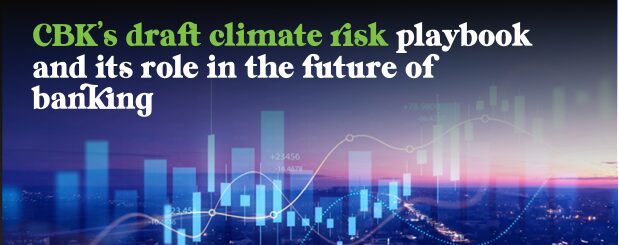CBK’s draft climate risk playbook and its role in the future of banking

This year, extreme weather events have caused devastating floods in various parts of the world, destroying whole towns and valuable infrastructure. Many people lost their homes, livelihoods, and, tragically, their loved ones. No country has been spared, from Dubai to Brazil and, more recently, the US, where Elon Musk had to make Starlink available for free due to the loss of power and inaccessibility of the ravaged areas. Despite their diverse climates and geography, these countries all face climate-related risks, which can strike anywhere and at any time, underscoring the urgent need for mitigation.
African countries, including Kenya, are particularly vulnerable to these risks, despite contributing the least to global warming.
Financial institutions are affected by climate change risks and must take them into account as part of their overall risk management strategies. This is why the Climate Risk Disclosure Framework recently developed by the Central Bank of Kenya (CBK) recognises these risks and introduces several significant advancements compared to previous guidelines and practices within the banking sector. Prior to this new framework, CBK had the following:
- The Guidance on Climate-Related Risk Management (2021). This was the primary guideline for banks in Kenya to manage climate-related risks. It aimed to provide a structured framework for integrating climate considerations into governance, strategy, and risk management.
- Sustainable Finance Initiative (SFI) Guiding Principles (2015), spearheaded by the Kenya Bankers Association, aimed to help financial institutions integrate sustainability into their operations and decision-making processes.
- The Kenya Green Bond Programme (2017), which encouraged banks and financial institutions to raise capital for green projects through green bonds.
It also relied on the Task Force on Climate-Related Financial Disclosures (TCFD) Recommendations, which, though not issued by the CBK, was widely referenced by Kenyan financial institutions and is also referenced by the new framework.
The previous guidelines and initiatives primarily focused on raising awareness of climate risks and integrating them into governance and decision-making processes. However, the new Climate Risk Disclosure Framework takes this further by providing:
- A more detailed and structured approach to identifying, assessing, and disclosing these risks, recognising them as essential elements of overall financial risk management.
- Aligning with the latest International Financial Reporting Standards (IFRS) S2 and recommendations from the TCFD, which emphasise a standardised approach to climate risk disclosure, ensures that Kenyan banks adhere to international best practices, improving comparability and consistency in reporting.
- A distinction is made between physical risks (like extreme weather events) and transition risks (related to shifts in policy and market dynamics). This dual focus enables banks to better understand and prepare for the wide range of climate-related challenges they may face.
- A new feature in the form of a requirement for banks to conduct scenario analyses. The analyses assess a bank’s resilience under various climate scenarios, helping institutions understand potential future impacts on their operations and financial health.
- The introduction of specific reporting templates provides banks with practical tools to structure their climate risk disclosures. These templates guide banks in presenting their exposures to physical and transition risks, fostering transparency and ease of comparison.
- Stressing the importance of integrating climate risk considerations into governance processes, business strategies, and overall risk management frameworks. This marks a shift toward a more holistic approach to risk management within financial institutions.
- Introducing a principle of proportionality, allowing banks to tailor their climate risk disclosures based on their specific business models and risk profiles. This flexibility aims to accommodate institutions of varied sizes and capacities while still adhering to rigorous standards.
The obvious recommendations on capacity building, public accountability, and transparency are also made. Banks, therefore, have a more standardised approach to tackling climate risks in Kenya that is more aligned with international principles and best practices.
You may submit your proposals on the draft Framework by the end of this month.

